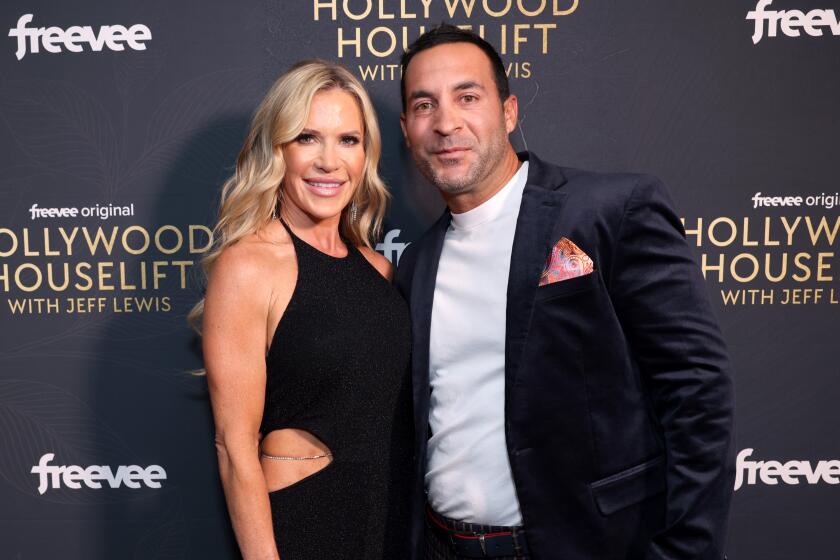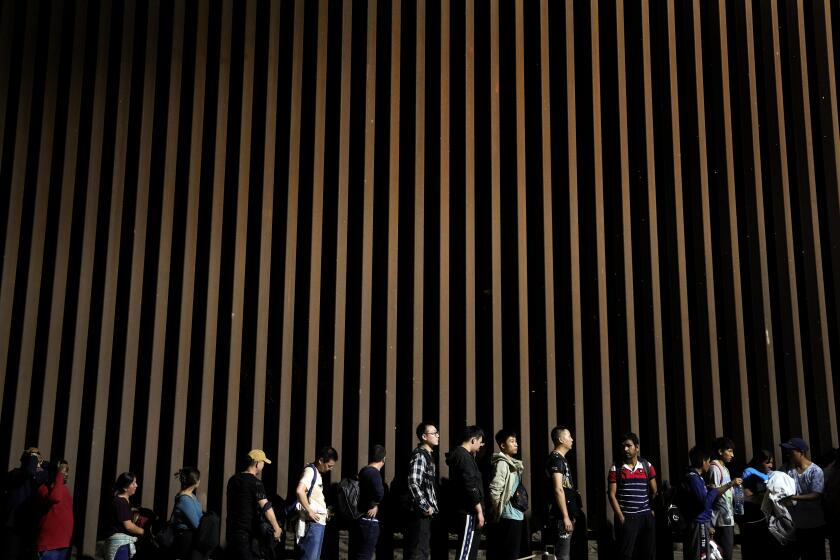Crossing the Line : At Ramona Gardens, Police Work Is More Than Carrying a Gun
On the hot August day they buried Arturo Jimenez, a day when residents of Ramona Gardens were less than enchanted with law enforcement, Los Angeles Housing Authority Police Officers Ramon Montijo and Kent Keyfauver were among the unlikeliest of mourners.
Their white squad car led the funeral procession at a 20-m.p.h. crawl down the San Bernardino Freeway. They stood erect during the burial in their starched uniforms, the black patch usually reserved for fallen officers pasted across their badges. When they left, each was holding a red carnation, a memorial to the homeboy slain by sheriff’s deputies at the East Los Angeles project.
“I know a lot of cops can’t understand it, but this is our community,” said Keyfauver, who has walked a foot beat in Ramona Gardens for the last 1 1/2 years. “We are nothing but an extension of these people, just dressed up in uniform.”
At a time when police work has tended to be viewed as a war of “we versus them,” these two Housing Authority officers are blurring the battle lines. It is not so much an enlightened philosophy as it is a question of survival, they say, a pragmatic approach forged by the realities of daily life in a potentially hostile environment.
Sometimes, such as when they placed the black patches over their badges--a sign of respect for Jimenez’s grieving mother, they said--it means crossing a line that most law enforcement agencies are unwilling to cross.
“You can damn well be sure my people would not have done that,” said Los Angeles Police Capt. Bob Medina, whose Hollenbeck station also covers Ramona Gardens. “That patch is reserved for a fallen comrade . . . not a confirmed gang member.”
Although Keyfauver and Montijo said they knew Jimenez was a gang member, and once even detained him for a Los Angeles police officer who wanted to question him about a robbery, they said they did not consider him among the project’s most hard-core youths.
They also said that, by attending the funeral, they knew they risked alienating other officers who might consider that a slap at the two sheriff’s deputies involved in the fatal shooting. But such traditional guidelines regulating officers’ conduct are precisely the rules Keyfauver and Montijo believe they must bend.
“Would I do it again? It’s touchy. I don’t know the answer to that,” Keyfauver said. “But a lot of the lines they draw I totally disagree with. I think that’s what’s killing law enforcement and bringing on a lot of our problems.”
In recent months, Keyfauver and Montijo have struggled to draw new lines--”policing by mutual consent,” they call it.
They each wear bulletproof vests and carry a back-up gun in the event their service revolvers are ever snatched away. Yet they talk of organizing the Ramona Gardens gang members into a citizens patrol that would help them police the 32-acre project.
They have made drug busts, served search warrants and been the first to arrive at the scene of drive-by shootings. They also have helped youths find drug counseling, played in neighborhood softball games and even served as ushers at the wedding of a female resident whose brothers have all had scrapes with the law.
Last month, they were scorned by some of the young toughs after leading an early morning raid on an apartment unit, where they seized five grams of cocaine, a handgun, a shotgun, $6,000 in cash and a BMW. But in an effort to avoid hard feelings with the suspects, they bought them a take-out breakfast from McDonalds before booking them at the station.
“They wear a badge just like the rest of them . . . so they do catch heat,” said Humberto Madrigal, 30. “But they talk cool to you, with respect. They know how to treat a person from the projects.”
The Los Angeles Police Department, which was urged by the Christopher Commission to adopt a “community-based policing” approach in the wake of the Rodney G. King beating, also talks about the need to interact with the public in a non-confrontational manner.
To that end, the Hollenbeck division has assigned a special foot-patrol team of seven officers to six East Los Angeles housing projects, including Ramona Gardens, where they say they usually stop by at least once every day. Besides handling 911 radio calls, they hand out candy, give away Dodger tickets, paint over graffiti and provided security recently while dozens of cockroach-infested apartments were fumigated.
But Officer Mike Marchello, field supervisor for the foot-patrol team, said his job would be troublesome if he did not know when to lay down the line that he believes necessarily separates police from the public.
“I think it’s very difficult to police a place if you’re real buddy-buddy with everyone,” Marchello said. “It’s hard enough to draw that line anyway. If (Housing Authority officers) can do it their way, that’s great . . . but to me that might cause conflict.”
Like Keyfauver and Montijo, the entire Housing Authority Police Department is grappling to define its role.
The department has been considered a dumping ground for “wanna-bes,” those officers rejected by larger agencies for lack of qualifications or a marred record. There were also a few embarrassing incidents, such as the Housing Authority officer convicted in 1985 of robbing a self-service gas station and, three years earlier, the officer who shot a man in the back--he said it was accidental--during a foot chase at Mar Vista Gardens.
Today, all recruits receive the same training as any other peace officer and are required to graduate from a state-approved academy. In an effort to inspire professionalism, Chief Roger Chandler, a former sheriff’s lieutenant, last year drafted a mission statement calling his department “the guardian of the human right to live peacefully as a resident of public housing.”
Still, his officers’ pay remains more than $12,000 below the top annual salary of Los Angeles patrol officers, and he has only 57 sworn personnel to cover 21 city-run projects, home to nearly 30,000 people from Pacoima to San Pedro.
“They’re really being pulled in every direction right now,” said Marshall J. Kandell, the Housing Authority’s public information director. “One school of thought says beef them up so they can do all the major law enforcement work. The other school says leave that kind of work to the LAPD and let our guys do the purely community-based stuff.”
For the moment, they are trying to do what they can of each. On a daily basis, Los Angeles police officers take the bulk of emergency calls for the projects, and because the Housing Authority has no detective bureau, Los Angeles police handle most follow-up investigations.
The Sheriff’s Department, whose turf borders several of the projects, also will occasionally enter as part of an investigation or during a pursuit, according to both police and sheriff’s officials.
In Ramona Gardens, Housing Authority officers spend much of their time working with troubled youths, being confidants to worried parents and serving as guardians of the fragile peace for hundreds of decent, clock-punching people.
It means they and their colleagues throughout the city sometimes get chided for doing feel-good work while leaving the nitty-gritty policing to the big-league departments. Yet, in the first seven months of this year, Housing Authority officers have responded to 2,316 radio calls, made 389 felony arrests, issued 847 misdemeanor citations, handed out 2,910 parking tickets and served 101 summonses, many of them eviction notices.
“If they can teach us anything, it’s humility,” said Robert Feliciano, a management consultant to law enforcement agencies, who served as chief of the Housing Authority police from 1979 to 1985. “When you got your posterior stuck out in the cold and your back-up could be an hour away . . . you learn you don’t kick the (expletive) out of everybody just because they may not like you.”
Walking past the colorful Mexican-American murals and gang graffiti that cover the facades of Ramona Gardens’ 497 apartments, Montijo and Keyfauver appear to be practicing what they preach.
They visit a young gang member for whom they have been trying to find a job; they stop by the apartment of a woman to lend a few words of advice for controlling her teen-age daughters; they patiently try to make sense of a middle-aged man’s drunken blather and they chat with a despondent homegirl as she sits staring at the small cross that still stands on the spot where Jimenez was killed.
“If these people didn’t want us in here, they wouldn’t let us be here,” Keyfauver said. “Any police officer who has the idea that he can actually control the neighborhood is sadly mistaken.”
Keyfauver, 31, a five-year veteran who grew up in an Anglo, middle-class Orange County neighborhood, is the talker and front man. Lean, earnest and clean-shaven, he submitted a proposal two years ago calling for two “Development Resource Officers” who would be exclusively assigned to a foot beat in the Ramona Gardens community.
Montijo, 50, who grew up in an East Los Angeles housing project, seems more like a smiling, mustachioed uncle who asks elderly women what they are cooking for dinner and calls the young children mi hijo or mi hija (my son or my daughter). A former Los Angeles police officer who left the department in 1977 and later started his own bodyguard service, he joined the Housing Authority in 1983 because he said it was one of the few agencies willing to hire someone his age.
“I’m a completely different cop than I used to be,” said Montijo, known as “Mojo” throughout the project. “I had the idea that it was ‘them and us’ . . . that enforcement was the way to go. But those barriers have to be broken. If you’re negative . . . you’re going to fail.”
One night earlier this year, Keyfauver learned that lesson. A few days before, an off-duty Los Angeles police officer officer had shot and killed a Ramona Gardens youth who allegedly had tried to rob him with a toy gun. All of a sudden, Keyfauver found himself in the middle of a hostile crowd eager to take out their frustrations on anyone wearing a badge.
He had to pull his revolver out and push back one attacker with his other hand, he said. Finally, the people backed off and allowed him to slip into a patrol car.
“I could have shot him and been in the right, but here I would have been totally wrong,” Keyfauver said. “I probably never would have been able to come back again.”
More to Read
Start your day right
Sign up for Essential California for news, features and recommendations from the L.A. Times and beyond in your inbox six days a week.
You may occasionally receive promotional content from the Los Angeles Times.






